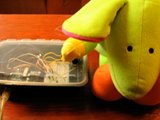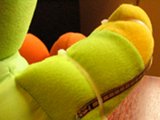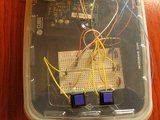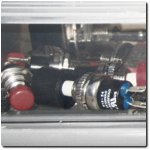You are hereHome / Arduino Projects / Project Page: Monski Pong
Project Page: Monski Pong
Monski Pong
 Monski Pong is MTT project #1 and of course dominates the cover of the book. Bending a stuffed animal’s arms will move a pong paddle on a PC screen. This project introduced me to flex sensors and so introduced me to sourcing parts that I cannot get locally.
Monski Pong is MTT project #1 and of course dominates the cover of the book. Bending a stuffed animal’s arms will move a pong paddle on a PC screen. This project introduced me to flex sensors and so introduced me to sourcing parts that I cannot get locally.
Sourcing parts
It’s easy to find common parts such as capacitors, resistors and LEDs near my home. More exotic parts need to be ordered on-line, which means not only having to wait for them to arrive but being forced to consider shipping when calculating the cost of your hobby. It pays to be strategic and anticipate things that you will need in the future to lower the per item premium that shipping adds.
Building the project
I thought that the most difficult part of this project would be borrowing the stuffed animal from my 4 year old. She was OK with it, though, especially since I opted to use the non-destructive attachment method of cable tying the sensors to the outside of the animal’s arms. She did not have a monkey so I choose a mouse that we nicknamed Verde Maisy because of its hue and resemblance to a popular character in children’s books.
 The most difficult part of the project proved to be figuring out how to attach the flex sensors to the breadboard. “Connect long wires to the flex sensors” was all the instruction that Igoe offered. The pins on the sensors are so close to the plastic that I thought trying to solder to them would have been disastrous. Since I was new to all this I had no clue what to do.
The most difficult part of the project proved to be figuring out how to attach the flex sensors to the breadboard. “Connect long wires to the flex sensors” was all the instruction that Igoe offered. The pins on the sensors are so close to the plastic that I thought trying to solder to them would have been disastrous. Since I was new to all this I had no clue what to do.
After internet searching for a long time I was finally turned on to the technique of wire wrapping. Oddly, the breakthrough piece of information came by way a caption to a flickr photo. Fortunately, the wire wrapping tool and wire were affordable and available locally. For the record, Igoe does mention wire wrapping in the book but not until the following chapter.
 Besides Verde Maisy, and the flex sensors, the project consisted of two buttons, one to serve and the other to reset the score, an Arduino and a breadboard. The project box was a plastic food container that I found in a kitchen cabinet.
Besides Verde Maisy, and the flex sensors, the project consisted of two buttons, one to serve and the other to reset the score, an Arduino and a breadboard. The project box was a plastic food container that I found in a kitchen cabinet.
Lessons learned
Of course I learned about serial communications, flow control, flex sensors and the ancient art of wire wrapping, but I think that the most valuable lesson from this project came when I let my daughter have a turn. If I remember correctly my words were something like “HEY, BE GENTLE”. It gave me a new appreciation for industrial design and the robustness of the things around us that we use everyday.
